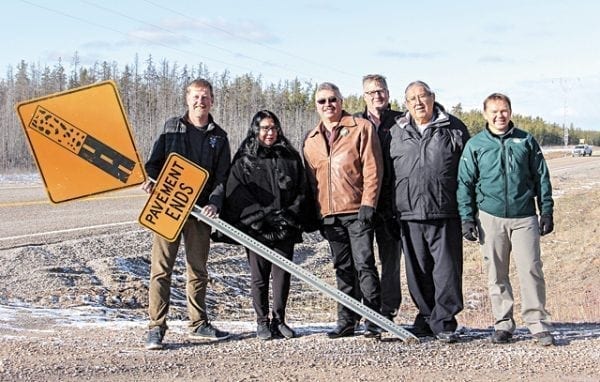Highway 5's final gravel section – which was completely chipsealed as of last month – was given a ceremonial farewell on Oct. 13.

Northwest Territories MP Michael McLeod and representatives from Hay River, Fort Smith and Wood Buffalo National Park were on hand to officially bid farewell to the 64 kilometres of gravel road through the park.
The event was held at Angus Tower, where the gravel section of Highway 5 used to begin about a 100-kilometre drive from Hay River
McLeod noted he once lived in Fort Smith for almost three years and drove the road many times.
"Most of us here have something in common. We probably all said at one point, 'Geez, I wish they would pave this road,'" he said at the ceremonial opening. "And I spent many years trying to do that."
McLeod said he tried to get funding to complete the chipsealing as an MLA and since being elected to the federal parliament.
The MP said he promoted the project as a way to improve safety and as a benefit during the upcoming Arctic Winter Games to be co-hosted by Hay River and Fort Smith.
"It took a little bit of work. It took me 14 years, but I think the people in Hay River and Fort Smith who use this road on a regular basis waited a lot longer than that," he said. "But it's done today."
As part of the federal budget in 2016, more than $27 million was allocated to chipseal the 64-kilometre gravel section of Highway 5. The work also included roadway widening where necessary, replacement of drainage culverts, and improvement of slope stability and drainage along the section of highway.
The all-weather road first opened in 1966 to replace a winter road.
Over the years, chipsealing from both ends of the highway crept closer and closer together, until only 64 kilometres of unpaved road was left through Wood Buffalo National Park.
"For 51 years, residents of the South Slave have been driving Highway 5 in order to visit friends and family, travel for business or pleasure, or access to the land to engage in traditional practices. It's more than just a highway," said McLeod. "This is a vital transportation corridor that has connected the communities of Fort Smith and Hay River to the rest of the world, Indigenous people to the lands that nurture them and thousands of visitors to the natural wonders of Wood Buffalo National Park."
The MP said, with a fully chipsealed road, winter and summer travel will be safer than ever and more people will visit the South Slave and Wood Buffalo National Park.
Cam Zimmer, the superintendent of Wood Buffalo National Park, said the final chipsealing of Highway 5 has been a long time coming.
"I think it's been decades of the communities of Hay River and Fort Smith wanting this road chipsealed," he said, although he noted it was a well-maintained road. "But it was still a gravel road."
The road was maintained and snow was cleared under a service agreement with the territorial Department of Transportation, and that agreement will continue.
Zimmer noted the people of Fort Smith and Hay River will really benefit the most from the completely chipsealed road.
"It's now complete," he said. "It's a very nice road to drive."
Plus, Zimmer expects more tourists will use the road to see Wood Buffalo National Park, noting some were previously reluctant to drive RVs and campers on a gravel road.
"We really hope that it's going to lead to increased visitation," he said.
Mayor Brad Mapes of Hay River was also on hand for the ceremony.
"I've always been a big believer that our two communities are really one big family," he said of Hay River and Fort Smith, adding that the completely chipsealed road will make it safer to travel between the two towns.
"Our two communities need to be able to bond and this road is one way to bond," Mapes added.
Fort Smith deputy mayor Kevin Smith – noting that he drove on the newly-chipsealed section for the first time to make it to the ceremony – said the economic opportunities are huge from increased tourism.
"So we're really excited about that and what that's going to bring to the town of Fort Smith," he said.
Like Mapes, Smith said the newly-chipsealed road will mean more partnership-building between Fort Smith and Hay River, and added, "Improved infrastructure is going to mean we can do more things together."